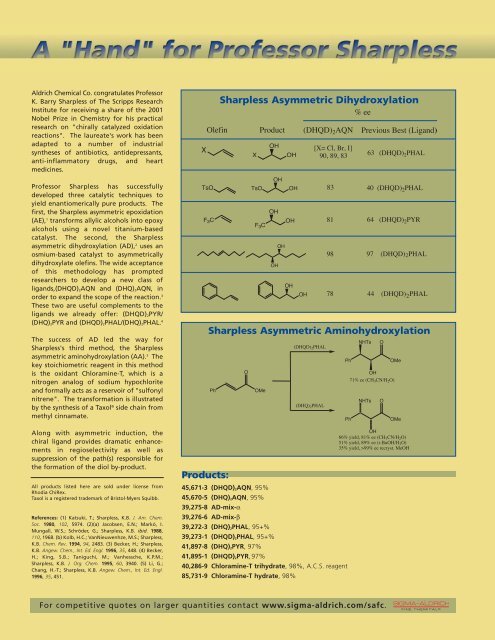DEDICATED TO PROFESSOR HC BROWN ON HIS ... - Sigma-Aldrich
DEDICATED TO PROFESSOR HC BROWN ON HIS ... - Sigma-Aldrich
DEDICATED TO PROFESSOR HC BROWN ON HIS ... - Sigma-Aldrich
Create successful ePaper yourself
Turn your PDF publications into a flip-book with our unique Google optimized e-Paper software.
<strong>Aldrich</strong> Chemical Co. congratulates Professor<br />
K. Barry Sharpless of The Scripps Research<br />
Institute for receiving a share of the 2001<br />
Nobel Prize in Chemistry for his practical<br />
research on "chirally catalyzed oxidation<br />
reactions". The laureate's work has been<br />
adapted to a number of industrial<br />
syntheses of antibiotics, antidepressants,<br />
anti-inflammatory drugs, and heart<br />
medicines.<br />
Professor Sharpless has successfully<br />
developed three catalytic techniques to<br />
yield enantiomerically pure products. The<br />
first, the Sharpless asymmetric epoxidation<br />
(AE), 1 transforms allylic alcohols into epoxy<br />
alcohols using a novel titanium-based<br />
catalyst. The second, the Sharpless<br />
asymmetric dihydroxylation (AD), 2 uses an<br />
osmium-based catalyst to asymmetrically<br />
dihydroxylate olefins. The wide acceptance<br />
of this methodology has prompted<br />
researchers to develop a new class of<br />
ligands,(DHQD)2AQN and (DHQ)2AQN, in<br />
order to expand the scope of the reaction. 3<br />
These two are useful complements to the<br />
ligands we already offer: (DHQD)2PYR/<br />
(DHQ)2PYR and (DHQD)2PHAL/(DHQ)2PHAL. 4<br />
The success of AD led the way for<br />
Sharpless's third method, the Sharpless<br />
asymmetric aminohydroxylation (AA). 5 The<br />
key stoichiometric reagent in this method<br />
is the oxidant Chloramine-T, which is a<br />
nitrogen analog of sodium hypochlorite<br />
and formally acts as a reservoir of "sulfonyl<br />
nitrene". The transformation is illustrated<br />
by the synthesis of a Taxol ® side chain from<br />
methyl cinnamate.<br />
Along with asymmetric induction, the<br />
chiral ligand provides dramatic enhancements<br />
in regioselectivity as well as<br />
suppression of the path(s) responsible for<br />
the formation of the diol by-product.<br />
All products listed here are sold under license from<br />
Rhodia ChiRex.<br />
Taxol is a registered trademark of Bristol-Myers Squibb.<br />
References: (1) Katsuki, T.; Sharpless, K.B. J. Am. Chem.<br />
Soc. 1980, 102, 5974. (2)(a) Jacobsen, E.N.; Markó, I.<br />
Mungall, W.S.; Schröder, G.; Sharpless, K.B. ibid. 1988,<br />
110, 1968. (b) Kolb, H.C.; VanNieuwenhze, M.S.; Sharpless,<br />
K.B. Chem. Rev. 1994, 94, 2483. (3) Becker, H.; Sharpless,<br />
K.B. Angew. Chem., Int. Ed. Engl. 1996, 35, 448. (4) Becker,<br />
H.; King, S.B.; Taniguchi, M.; Vanhessche, K.P.M.;<br />
Sharpless, K.B. J. Org. Chem. 1995, 60, 3940. (5) Li, G.;<br />
Chang, H.-T.; Sharpless, K.B. Angew. Chem., Int. Ed. Engl.<br />
1996, 35, 451.<br />
Products:<br />
Sharpless Asymmetric Dihydroxylation<br />
Sharpless Asymmetric Aminohydroxylation<br />
45,671-3(DHQD)2AQN, 95%<br />
45,670-5 (DHQ)2AQN, 95%<br />
39,275-8 AD-mix-α<br />
39,276-6 AD-mix-β<br />
39,272-3 (DHQ)2PHAL, 95+%<br />
39,273-1 (DHQD)2PHAL, 95+%<br />
41,897-8 (DHQ)2PYR, 97%<br />
41,895-1 (DHQD)2PYR, 97%<br />
40,286-9 Chloramine-T trihydrate, 98%, A.C.S. reagent<br />
85,731-9 Chloramine-T hydrate, 98%<br />
For competitive quotes on larger quantities contact www.sigma-aldrich.com/safc.

















